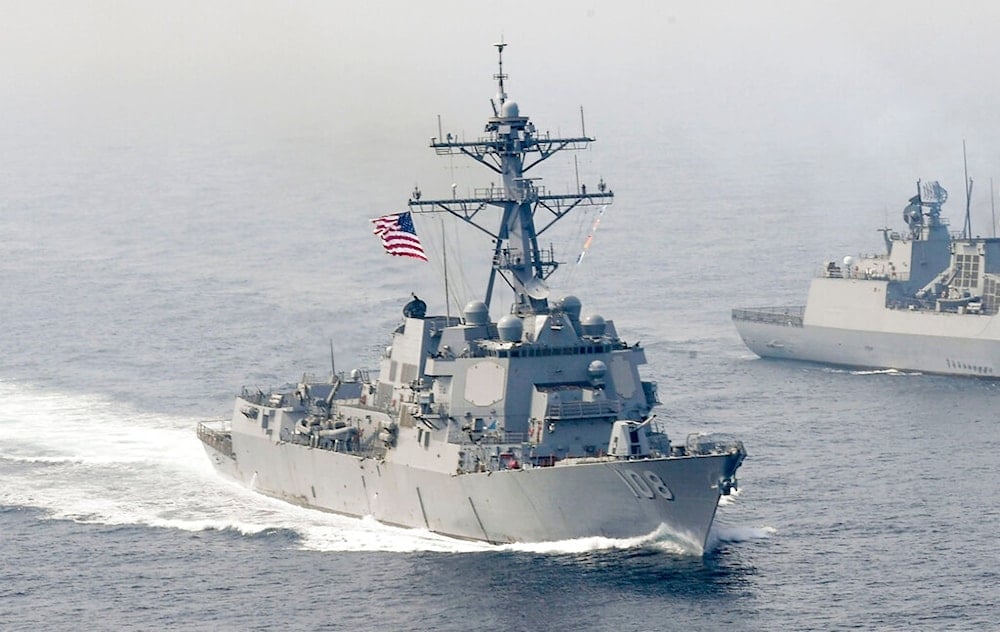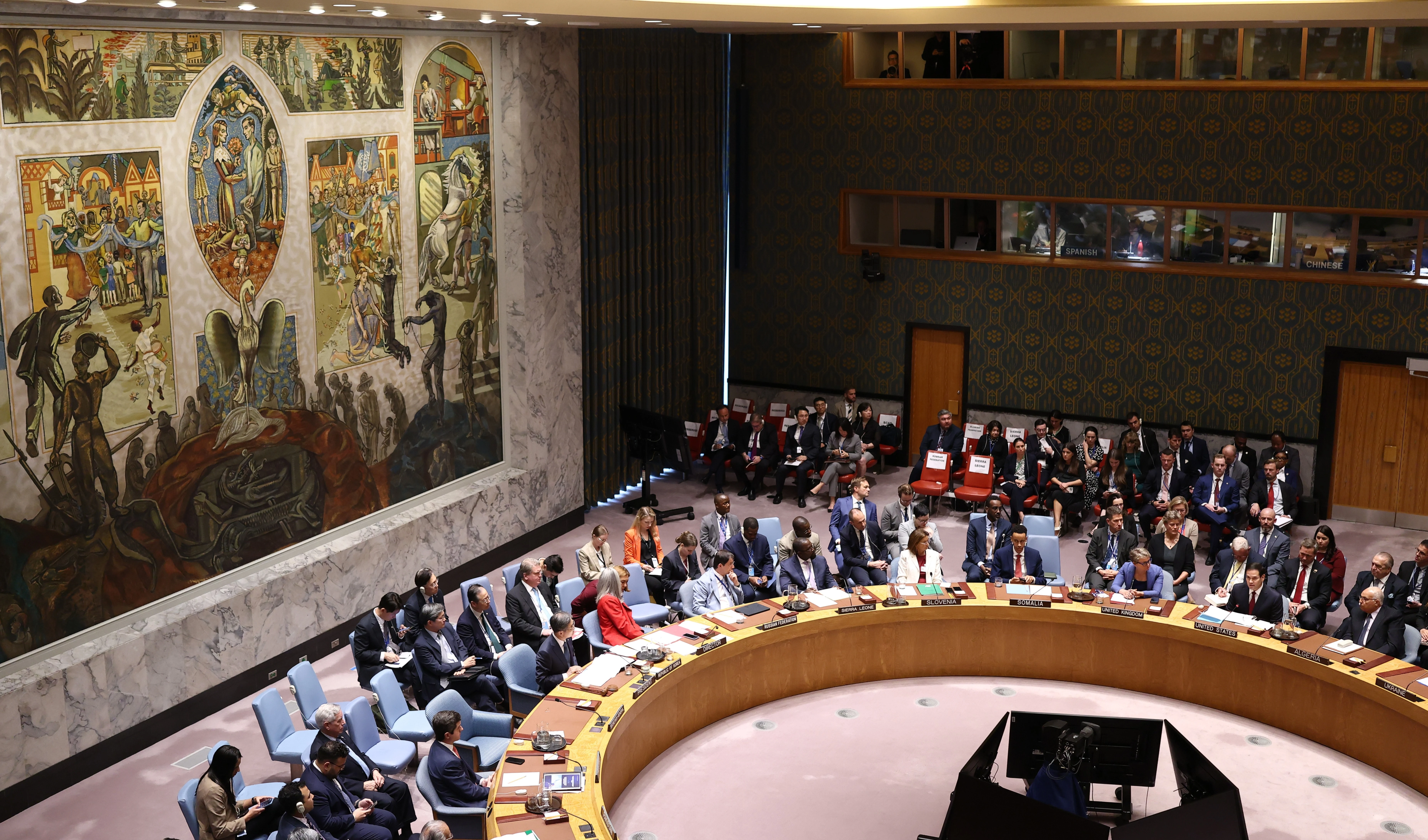New US destroyer spotted near Indian Ocean base amid rising tensions
The sighting comes at a time of heightened tensions, following threats by US President Donald Trump to bomb Iran if a deal on its nuclear program was not reached.
-
 In this Tuesday, April 25, 2017, file photo released by the US Navy, the Arleigh Burke-class guided-missile destroyer USS Wayne E. Meyer, left, is underway during a bilateral exercise with South Korea (Mass Communication Specialist 3rd Class Kelsey L. Adams/US Navy via AP)
In this Tuesday, April 25, 2017, file photo released by the US Navy, the Arleigh Burke-class guided-missile destroyer USS Wayne E. Meyer, left, is underway during a bilateral exercise with South Korea (Mass Communication Specialist 3rd Class Kelsey L. Adams/US Navy via AP)
Satellite imagery analyzed by open-source intelligence analyst @MT_Anderson has revealed the presence of a US Navy destroyer, believed to be the USS Wayne E. Meyer (DDG-108), operating near Diego Garcia—a remote yet strategically significant island in the Indian Ocean, BulgarianMilitary.com reported.
The images posted on X show the warship, which carries a crew of about 300 personnel, approximately 650 kilometers northeast of the island. The sighting comes at a time of heightened tensions, following threats by US President Donald Trump to bomb Iran if a deal on its nuclear program was not reached. Trump has set a two-month deadline for Iran to negotiate an agreement, but it remains unclear when that countdown began.
The Leader of the Islamic Revolution, Sayyed Ali Khamenei, said he does not believe the US will attack Iran but warned that if it does, "they will certainly receive a heavy blow in return."
His senior advisor, Ali Larijani, warned that any US or Israeli attack on Iran under the pretext of its nuclear program would force Tehran to move toward producing nuclear weapons.
The Arleigh Burke-Class Guided-Missile Destroyer USS Wayne E. Meyer (DDG-108) was recently spotted en route to Diego Garcia Air Base in the Indian Ocean.
— OSINTWarfare (@OSINTWarfare) April 4, 2025
Equipped with the advanced AEGIS Integrated Air Defense System (IADS), the Destroyer is expected to bolster the island’s… pic.twitter.com/o9SA412tvG
Commissioned in 2009 and named after Rear Adm. Wayne E. Meyer, the Arleigh Burke-class destroyer represents one of the most advanced vessels in the US Navy, BulgarianMilitary.com highlighted.
It added that as a Flight IIA variant, it spans 509 feet in length, has a displacement of around 9,200 tons, and is powered by four General Electric LM2500-30 gas turbines, enabling it to exceed speeds of 30 knots.
At the core of USS Wayne E. Meyer's capabilities is the Aegis Baseline 9.2.1 system (BMD 5.1), integrating the powerful SPY-1D(V) radar with an arsenal that includes SM-3 and SM-6 interceptors, the website emphasized.
According to the report, the destroyer's 96 vertical launch system (VLS) cells can be armed with a range of weapons—from ballistic missile interceptors to Tomahawk land-attack and anti-ship missiles—enabling the ship to counter aerial, missile, and maritime threats.
USS Wayne E. Meyer's presence near Diego Garcia suggests a mission focused on airspace defense and countering Iranian missile capabilities, BulgarianMilitary.com indicated, although the Pentagon has not officially confirmed the deployment or its purpose.
Meet the Diego Garcia strategic base
Diego Garcia itself holds immense strategic value. Located within the Chagos Archipelago, this 12-square-mile atoll has been a cornerstone of US military power projection since the Cold War.
It has historically served as a launch point for US strategic bombers and long-range missions. The base was pivotal in US-led military operations during the Gulf War, the war on Iraq, and the war on Afghanistan and has been used for air campaigns against countries in the Middle East and South Asia.
It is one of two critical US bomber bases in the Indo-Pacific region, alongside Andersen Air Force Base in Guam. It has been used as a joint UK–US military base since the 1970s.
Between 1968 and 1973, the island’s native Chagossian population—more than 1,500 people—was forcibly removed under a secretive US-UK agreement to make way for a military base. In exchange for leasing the island, the US reportedly received a discount on Polaris missile systems.
The UK retains sovereignty over the territory as part of the British Indian Ocean Territory.
BulgarianMilitary.com pointed out that Diego Garcia's geographic isolation—over 1,000 miles from major landmasses—makes it secure from conventional threats while still allowing the US to project power across the Middle East, South Asia, and beyond.
The Deputy Commander of Iran's Islamic Revolution Guard Corps (IRGC), Brigadier General Ali Fadavi, asserted that Iran's response to any aggression will be proportionate and may even exceed what its adversaries attempt, highlighting that IRGC forces are eagerly awaiting a confrontation with the United States.
Fadavi, in an exclusive statement for Al Mayadeen, remarked that the US has had presidents more reckless than Trump, citing former president Ronald Reagan as an example. He recalled how Iran responded to American aggression in the Gulf during Reagan’s presidency by targeting US warships and helicopters, emphasizing that Iran’s military capabilities today are far superior to those of the 1980s.
Pentagon expands Middle East militarization with warplanes, carrier
A couple of days ago, US Defense Secretary Pete Hegseth ordered the deployment of additional warplanes to reinforce US military capabilities in the Middle East.
Hegseth also directed the USS Harry S. Truman, the flagship of Carrier Strike Group 8, and its accompanying vessels to remain within the US Central Command (CENTCOM) area of responsibility (AOR). The carrier was last confirmed in the northern Red Sea, where it has been serving as the primary launch pad for the US aggression against Yemen.
Further escalating the militarization of the region, the Pentagon announced that the USS Carl Vinson—along with the remaining warships of Carrier Strike Group 1—will enter CENTCOM’s AOR upon completing its current operations in the Indo-Pacific.
At least four B-2 Spirit stealth bombers have been relocated to Diego Garcia island in the Indian Ocean, as of March 26. Analysts suggest the bombers are being positioned for potential strikes against Yemen, noting that they were previously deployed in a similar operation under the last administration.
Beyond Yemen, the deployment is widely seen as a direct signal to Iran, underscoring Washington’s military buildup as part of broader pressure tactics to force Tehran into accepting an unfavorable deal.
Notably, the B-2 is capable of carrying GBU-57 Massive Ordnance Penetrator (MOP) bombs, designed to target deeply buried military and nuclear infrastructure, raising concerns that the move is also a preparatory step for strikes against fortified Iranian sites.
Read more: US-Iran war would set entire region ablaze: Iraqi official

 6 Min Read
6 Min Read









